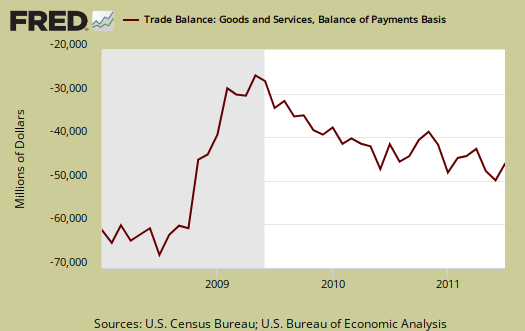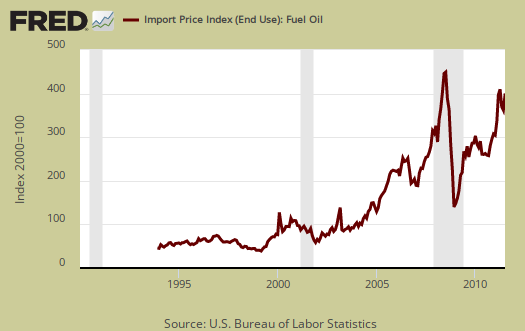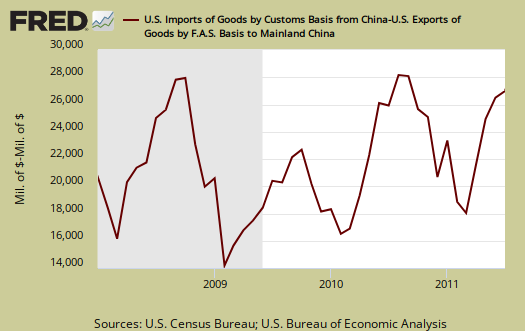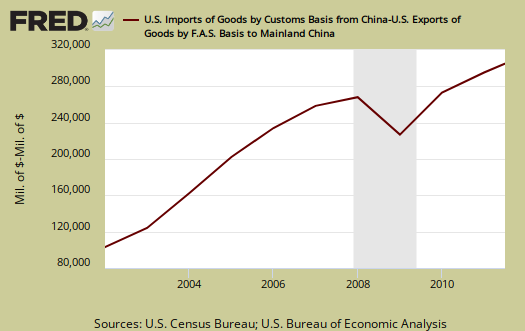The July 2011 U.S. trade deficit decreased $6.8 billion to $44.8 billion. This is a 13.11% monthly decrease in the trade deficit. Exports increased by $6.2 billion, or 3.61%, while imports decreased $0.5 billion, or 0.22%. China imports, not seasonally adjusted, increased 1.12% in July, creating a $27 billion trade deficit with China.

Oil related imports dropped another $2.5 billion with a petroleum end use trade deficit of $25.6 billion, for July, or 42.9% of the goods trade deficit, and a monthly decrease of 12.9%.
This is better news for Q3 GDP since trade deficits negatively impact economic growth. Q2 2011 GDP should also get a revision boost since June imports were revised down by $0.6 billion, although watch out, those price deflators used for real GDP computation are tricky.
The United States basically has two major ongoing problems with the trade deficit, Chinese goods and Oil imports. Below is the not seasonally adjusted import price index for oil fuel. In July the average price for a barrel of oil was $104.27, down from June's price of $106.

Below is the raw customs basis accounting of the trade deficit with China, not seasonally adjusted. China alone was 40.7% of the goods trade deficit for July. This includes oil. For comparison's sake the not seasonally adjusted goods trade deficit by Census accounting methods was $66.27 billion. For the 2011 year to date, the trade deficit with China is $160.37 billion, which is 40% of the total goods accumulated trade deficit, which again includes petroleum imports on aggregate.

Below are imports vs. exports of goods and services from January 2007 to June 2011. Notice how much larger imports are than exports, but also notice the growth, or rate of change between months of U.S. exports over time. This month had solid bump up in exports.

Below is the list of good export increases from June to July, seasonally adjusted. Industrial supplies and materials exports, which includes fuel oil, increased 6.93% from June. Fuel oil was 45.14% of the total export increase in this category. Capital goods also had a major increase of 5.54% in comparison to last month. Automotive increased 11.7% from June.
- Automotive vehicles, parts, and engines: +$1.262 billion
- Industrial supplies and materials: +$2.736 billion
- Other goods: +$0.211 billion
- Foods, feeds, and beverages: -$0.26 billion
- Capital goods: +$2.211 billion
- Consumer goods: -$0.637 billion
Exhibit 7 gives Census accounting method breakdown for exports.
Here are the goods import monthly changes, seasonally adjusted. Industrial materials dropped by -3.79%. Oil and Petroleum products were 88.63% of industrial materials imports decline. Auto imports surged by 15.01%, but this could be due to Japan coming back online after the tsunami. Japan's imports increased 11.8% from last month. Notice unspecified in this report, other goods, had an unusual drop.
- Industrial supplies and materials: -$2.462 billion
- Capital goods: +$0.276 billion
- Foods, feeds, and beverages: -$0.309 billion
- Automotive vehicles, parts, and engines: +$2.908 billion
- Consumer goods: +$0.68 billion
- Other goods: -$1.025 billion
Running a trade deficit in advanced technology is not a good sign for those jobs of tomorrow. This deficit is increasing almost every month, meaning we are literally outsourcing America's future.
Advanced technology products exports were $23.6 billion in July and imports were $32.7 billion, resulting in a deficit of $9.1 billion. July exports were $1.1 billion less than the $24.7 billion in June, while July imports were $0.8 billion less than the $33.5 billion in June.
Here is the breakdown with major trading partners, not seasonally adjusted. China is the worst trade deficit, with $27 billion, with last month's China deficit being $26.7 billion. We are China's export dumping ground.
OPEC can be assumed to be oil and it decreased for June, but is not seasonally adjusted. OPEC accounts for about 54% of all crude oil imports by nation. Still we see every month, our problem is clearly China and oil imports. The amounts in parenthesis are May's deficit figures. Notice how the trade surplus list is super short.
The July figures show surpluses, in billions of dollars, Hong Kong $2.3 ($2.4 for June), Australia $1.7 ($1.4), Singapore $1.2 ($1.0), and Egypt $0.4 ($0.3).
Deficits were recorded, in billions of dollars, with China $27.0 ($26.7), OPEC $11.9 ($13.8), European Union $8.9 ($9.8), Japan $5.3 ($4.0), Mexico $4.9 ($6.4), Germany $4.2 ($4.0), Canada $3.2 ($2.8), Nigeria $2.8 ($3.0), Ireland $2.7 ($2.8), Venezuela $2.6 ($3.3), Taiwan $1.6 ($1.8), and Korea $1.4 ($1.6).
In 2008, we broke monthly total trade deficit figures of $60 billion. This includes goods and services.
Below is a graph of trade deficit with China, per year. 2010 was a record for a trade deficit with China. With 2011 having a China trade deficit, accumulated of -$160.36 billion by July, we're well on our way to break last year's record. by July 2010, one year ago, the cumulative China trade deficit was -$145.368 billion. We're already 10.32% above that.

Here is June's report overview (unrevised, although graphs are updated). Here is the BEA website for additional U.S. trade data.
You might ask what are these Census Basis versus Balance of Payment mentioned all over the place? The above mentions various accounting methods so we're comparing Apples to Apples and not mixing the fruit. The trade report in particular is difficult due to the mixing of these two accounting methods and additionally some data is seasonally adjusted and others are not. One cannot compare values from different accounting methods and have that comparison be valid.
In a nutshell, the Balance of Payments accounting method is where they make a bunch of adjustments to not count imports and exports twice, the military moving stuff around or miss some additions such as freight charges. The Census basis is more plain raw data the U.S. customs people hand over which is just the stuff crosses the border. The 2005 chain weighted stuff means it was overall modified for a price increase/decrease adjustment in order to remove inflation and deflation time variance stuff.
Bottom line, you want just the raw data of what's coming into the country and going out, it's the Census basis and additionally the details are only reported in that accounting format. Additionally the per country data is not seasonally adjusted so watch out trying to add those numbers into the overall trade deficit. It's a statistical no-no to mix seasonal and non-seasonally adjusted numbers.
The Census is also getting into the graphing game with some nice pie charts breaking down exports by country, as well as a chart showing petroleum as an overall percentage of the trade deficit.

Recent comments